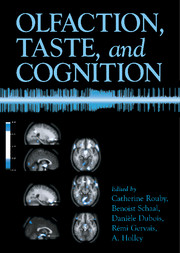Book contents
- Frontmatter
- Contents
- Contributors
- Preface
- Acknowledgments
- A Tribute to Edmond Roudnitska
- OLFACTION, TASTE, AND COGNITION
- Section 1 A Specific Type of Cognition
- Section 2 Knowledge and Languages
- Section 3 Emotion
- 8 Acquisition and Activation of Odor Hedonics in Everyday Situations: Conditioning and Priming Studies
- 9 Is There a Hedonic Dimension to Odors?
- 10 Influences of Odors on Mood and Affective Cognition
- 11 Assessing Putative Human Pheromones
- 12 Neural Correlates of Emotion Perception: From Faces to Taste
- Section 4 Memory
- Section 5 Neural Bases
- Section 6 Individual Variations
- Index
- References
12 - Neural Correlates of Emotion Perception: From Faces to Taste
Published online by Cambridge University Press: 21 September 2009
- Frontmatter
- Contents
- Contributors
- Preface
- Acknowledgments
- A Tribute to Edmond Roudnitska
- OLFACTION, TASTE, AND COGNITION
- Section 1 A Specific Type of Cognition
- Section 2 Knowledge and Languages
- Section 3 Emotion
- 8 Acquisition and Activation of Odor Hedonics in Everyday Situations: Conditioning and Priming Studies
- 9 Is There a Hedonic Dimension to Odors?
- 10 Influences of Odors on Mood and Affective Cognition
- 11 Assessing Putative Human Pheromones
- 12 Neural Correlates of Emotion Perception: From Faces to Taste
- Section 4 Memory
- Section 5 Neural Bases
- Section 6 Individual Variations
- Index
- References
Summary
Is there a relationship between the brain regions involved in perception of others' emotions and those important for olfaction and taste? The aim of this chapter is to discuss the nature of emotions, and in particular the studies that have examined brain regions important in the perception of distinct emotions, such as fear and disgust, and then to demonstrate that similar brain regions are involved in the perception of odors and flavors and emotive stimuli presented in other sensory modalities.
What Is the Relationship among Olfaction, Taste, and Emotion?
Emotions
What are emotions, and why do we have them? Dualist, or “feeling,” theories proposed by Descartes and, in later years, by James (1890) describe emotions as epiphenomena, or nonfunctional feelings, separate from the physiological changes or behavior seen in response to provoking stimuli. Behaviorist theories, such as that of Skinner (1974), define emotions in terms of reinforced patterns of behavior. Cognitive theories dating from Aristotle emphasize the importance of cognitions as causal to emotions, with theorists such as Lyons (1992) describing the appraisal or interpretation of events, which then leads to physiological changes, as central to the formation of an emotion. Ekman (1992) has described emotions as “having evolved through their adaptive value in dealing with fundamental life-tasks.” He argues that emotions are characterized by several unique features, including distinctive facial expressions, distinctive physiology, their presence in other primates, and distinctive antecedent events (Ekman, 1992).
Information
- Type
- Chapter
- Information
- Olfaction, Taste, and Cognition , pp. 196 - 208Publisher: Cambridge University PressPrint publication year: 2002
References
Accessibility standard: Unknown
Why this information is here
This section outlines the accessibility features of this content - including support for screen readers, full keyboard navigation and high-contrast display options. This may not be relevant for you.Accessibility Information
- 8
- Cited by
